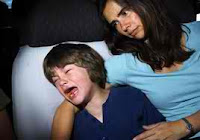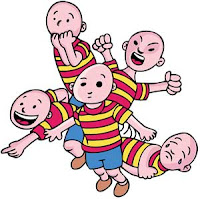The American Psychiatric Association's Diagnostic and Statistical Manual, Fourth Edition (DSM IV), defines oppositional defiant disorder (ODD) as a recurrent pattern of negativistic, defiant, disobedient, and hostile behavior toward authority figures that persists for at least 6 months. Behaviors included in the definition include the following:
• actively defying requests
• arguing with adults
• being touchy, easily annoyed or angered, resentful, spiteful, or vindictive.
• blaming others for one's own mistakes or misbehavior
• deliberately annoying other people
• losing one's temper
• refusing to follow rules
OPPOSITIONAL DEFIANT DISORDER is usually diagnosed when an Aspergers youngster has a persistent or consistent pattern of disobedience and hostility toward parents, teachers, or other adults. The primary behavioral difficulty is the consistent pattern of refusing to follow commands or requests by adults. Aspergers kids with OPPOSITIONAL DEFIANT DISORDER are often easily annoyed; they repeatedly lose their temper, argue with adults, refuse to comply with rules and directions, and blame others for their mistakes. Stubbornness and testing limits are common, even in early childhood.
The criteria for OPPOSITIONAL DEFIANT DISORDER are met only when the problem behaviors occur more frequently in the Aspergers youngster than in other Aspergers kids of the same age and developmental level. These behaviors cause significant difficulties with family and friends, and the oppositional behaviors are the same both at home and in school. Sometimes, OPPOSITIONAL DEFIANT DISORDER may be a precursor of a conduct disorder. OPPOSITIONAL DEFIANT DISORDER is not diagnosed if the problematic behaviors occur exclusively with a mood or psychotic disorder.
Prevalence and Comorbidity—
The base prevalence rates for oppositional defiant disorder (ODD) range from 1-16%, but most surveys estimate it to be 6-10% in surveys of nonclinical, non-referred samples of parents' reports. In more stringent population samples, rates are lower when impairment criteria are stricter and when the information is obtained from both parents and teachers, rather than from moms and dads only. Before puberty, the condition is more common in boys; after puberty, it is almost exclusively identified in boys, and whether the criteria are applicable to girls has been discussed. The disorder usually manifests by age 8 years. OPPOSITIONAL DEFIANT DISORDER and other conduct problems are the single greatest reasons for referrals to outpatient and inpatient mental health settings for kids, accounting for at least half of all referrals.
Diagnosis is complicated by relatively high rates of comorbid, disruptive, behavior disorders. Some symptoms of attention deficit hyperactivity disorder (ADHD) and conduct disorder overlap. Researchers have postulated that, in some kids, OPPOSITIONAL DEFIANT DISORDER may be the developmental precursor of conduct disorder. Comorbidity of OPPOSITIONAL DEFIANT DISORDER with ADHD has been reported to occur in 50-65% of affected kids.
In some Aspergers kids, OPPOSITIONAL DEFIANT DISORDER commonly occurs in conjunction with anxiety disorders and depressive disorders. Cross-sectional surveys have revealed the comorbidity of OPPOSITIONAL DEFIANT DISORDER with an affective disorder in about 35% of cases, with rates of comorbidity increasing with patient age. High rates of comorbidity are also found among ODDs, learning disorders, and academic difficulties. Given these findings, kids with significant oppositional and defiant behaviors often require multidisciplinary assessment and may need components of mental health care, case management, and educational intervention to improve.
Risk Factors and Etiology—
The best available data indicate that no single cause or main effect results in oppositional defiant disorder (ODD). Most experts believe that biological factors are important in OPPOSITIONAL DEFIANT DISORDER and that familial clustering of certain disruptive disorders, including OPPOSITIONAL DEFIANT DISORDER and ADHD, substance abuse, and mood disorders, occurs.
Studies of the genetics of OPPOSITIONAL DEFIANT DISORDER have produced mixed results. Under-arousal to stimulation has been consistently found in persistently aggressive and delinquent youth and in those with OPPOSITIONAL DEFIANT DISORDER. Exogenous factors such as prenatal exposure to toxins, alcohol, and poor nutrition all seem to have effects, but findings are inconsistent. Studies have implicated abnormalities in the prefrontal cortex; altered neurotransmitter function in the serotonergic, noradrenergic, and dopaminergic systems; and low cortisol and elevated testosterone levels.
Clinical Course—
In Aspergers toddlers, temperamental factors, such as irritability, impulsivity, and intensity of reactions to negative stimuli, may contribute to the development of a pattern of oppositional and defiant behaviors in later childhood. Family instability, including economic stress, parental mental illness, harshly punitive behaviors, inconsistent parenting practices, multiple moves, and divorce, may also contribute to the development of oppositional and defiant behaviors.
The interactions of an Aspergers youngster who has a difficult temperament and irritable behavior with moms and dads who are harsh, punitive, and inconsistent usually lead to a coercive, negative cycle of behavior in the family. In this pattern, the youngster's defiant behavior tends to intensify the parents' harsh reactions. The moms and dads respond to misbehavior with threats of punishment that are inconsistently applied. When the parent punishes the youngster, the youngster learns to respond to threats. When the parent fails to punish the youngster, the youngster learns that he or she does not have to comply. Research indicates that these patterns are established early, in the youngster's preschool years; left untreated, pattern development accelerates, and patterns worsen.
Developmentally, the presenting problems change with the Aspergers youngster's age. For example, younger kids are more likely to engage in oppositional and defiant behavior, whereas older kids are more likely to engage in more covert behavior such as stealing.
By the time they are school aged, Aspergers kids with patterns of oppositional behavior tend to express their defiance with teachers and other adults and exhibit aggression toward their peers. As kids with oppositional defiant disorder (ODD) progress in school, they experience increasing peer rejection due to their poor social skills and aggression. These kids may be more likely to misinterpret their peers' behavior as hostile, and they lack the skills to solve social conflicts. In problem situations, kids with OPPOSITIONAL DEFIANT DISORDER are more likely to resort to aggressive physical actions rather than verbal responses. Kids with OPPOSITIONAL DEFIANT DISORDER and poor social skills often do not recognize their role in peer conflicts; they blame their peers (e.g., "He made me hit him.") and usually fail to take responsibility for their own actions.
The following 3 classes of behavior are hallmarks of both oppositional and conduct problems:
1. emotional overreaction to life events, no matter how small
2. failure to take responsibility for one's own actions
3. noncompliance with commands
When behavioral difficulties are present beginning in the preschool period, teachers and families may overlook significant deficiencies in the youngster's learning and academic performance. When many Aspergers kids with behavioral problems and academic problems are placed in the same classroom, the risk for continued behavioral and academic problems increases. OPPOSITIONAL DEFIANT DISORDER behavior may escalate and result in serious antisocial actions that, when sufficiently frequent and severe, become criteria to change the diagnosis to conduct disorder. Milder forms of OPPOSITIONAL DEFIANT DISORDER in some kids spontaneously remit over time. More severe forms of OPPOSITIONAL DEFIANT DISORDER, in which many symptoms are present in the toddler years and continually worsen after the youngster is aged 5 years, may evolve into conduct disorder in older kids and adolescents.
Treatment—
Given the high probability that oppositional defiant disorder (ODD) occurs alongside attention disorders, learning disorders, and conduct disturbances, an evaluation for these disorders is indicated for comprehensive treatment. Pharmacologic treatment (e.g., stimulant medication) for ADHD may be beneficial once this is diagnosed. Aspergers kids with oppositional behavior in the school setting should undergo necessary screening testing in school to evaluate for possible learning disabilities. With the multifaceted nature of associated problems in OPPOSITIONAL DEFIANT DISORDER, comprehensive treatment may include medication, parenting and family therapy, and consultation with the school staff. If kids with OPPOSITIONAL DEFIANT DISORDER are found to have ADHD as well, appropriate treatment of ADHD may help them to restore their focus and attention and decrease their impulsivity; such treatment may enable their social and behavioral interventions to be more effective.
Parent management training (PMT) is recommended for families of Aspergers kids with OPPOSITIONAL DEFIANT DISORDER because it has been demonstrated to affect negative interactions that repeatedly occur between the kids and their moms and dads. PMT consists of procedures in which parents are trained to change their own behaviors and thereby alter their youngster's problem behavior in the home. PMT is based on 35 years of well-developed research showing that oppositional and defiant patterns arise from maladaptive parent-child interactions that start in early childhood.
These patterns develop when moms and dads inadvertently reinforce disruptive and deviant behaviors in a youngster by giving those behaviors a significant amount of negative attention. At the same time, the parents, who are often exhausted by the struggle to obtain compliance with simple requests, usually fail to provide positive attention; often, the moms and dads have infrequent positive interactions with their kids. The pattern of negative interactions evolves quickly as the result of repeated, ineffective, emotionally expressed commands and comments; ineffective harsh punishments; and insufficient attention and modeling of appropriate behaviors.
PMT alters the pattern by encouraging the parent to pay attention to prosocial behavior and to use effective, brief, non-aversive punishments. Treatment is conducted primarily with the moms and dads; the therapist demonstrates specific procedures to modify parental interactions with their youngster. Moms and dads are first trained to simply have periods of positive play interaction with their youngster. They then receive further training to identify the youngster's positive behaviors and to reinforce these behaviors. At that point, parents are trained in the use of brief negative consequences for misbehavior. Treatment sessions provide the moms and dads with opportunities to practice and refine the techniques.
Follow-up studies of operational PMT techniques in which moms and dads successfully modified their behavior showed continued improvements for years after the treatment was finished. Treatment effects have been stronger with younger kids, especially in those with less severe problems. Recent research suggests that less severe problems, rather than a younger patient age, is predictive of treatment success. Approximately 65% of families show significant clinical benefit from well-designed parent management programs.
Regardless of the Aspergers youngster's age, intervention early in the developing pattern of oppositional behavior is likely to be more effective than waiting for the youngster to grow out of it. These kids can benefit from group treatment. The process of modeling behaviors and reactions within group settings creates a real-life adaptation process. In younger kids, combined treatment in which moms and dads attend a PMT group while the kids go to a social skills group has consistently resulted in the best outcome. The efficacy of group treatment of adolescents with oppositional behaviors has been debated. Group therapy for adolescents with OPPOSITIONAL DEFIANT DISORDER is most beneficial when it is structured and focused on developing the skills of listening, empathy, and effective problem solving.
Obstacles to Treatment—
Oppositional defiant disorder (ODD), and other conduct problems, can be intractable. Despite advances in treatment, many Aspergers kids continue to have long-term negative sequelae. PMT requires parental cooperation and effort for success. Existing psychiatric conditions in the moms and dads can be a major obstacle to effective treatment. Depression in a parent, particularly the mother, can prevent successful intervention with the youngster and become worse if the youngster's behavior is out of control. Substance abuse and other more severe psychiatric conditions can adversely affect parenting skills, and these conditions are particularly problematic for the moms and dads of a youngster with OPPOSITIONAL DEFIANT DISORDER.
In situations in which the moms and dads lack the resources to effectively manage their Aspergers youngster, services can be obtained through schools or county mental health agencies. Many states have effective "wrap around" services, which include a full-day school program and home-based therapy services to maintain progress in the home setting. Thus, effective treatment can include resources from several agencies, and coordination is critical. If county mental health or school special education services are involved, one person is usually designated to coordinate services in those systems.
My Aspergers Child: Parent Management Training (PMT) for Parents with Defiant Aspergers Children
Keywords—
• Aspergers and ADHD
• Aspergers and antisocial actions
• Aspergers and attention-deficit/hyperactivity disorder
• Aspergers and conduct disorder
• Aspergers and defiant behavior
• Aspergers and defiant disorder
• Aspergers and disruptive behavior
• Aspergers and harshly punitive behaviors
• Aspergers and hostile behavior
• Aspergers and impulsivity
• Aspergers and irritability
• Aspergers and learning disorders
• Aspergers and maladaptive parent-child interactions
• Aspergers and noncompliance with commands
• Aspergers and ODD
• Aspergers and oppositional defiant disorder
• Aspergers and overreaction to life events
• Aspergers and parent management training
• Aspergers and peer rejection
• Aspergers and stubbornness
• Aspergers defiant disorder
• Aspergers negativistic behavior For many children with Asperger’s (AS) and High-Functioning Autism (HFA), problematic behaviors are common. The term “problematic behavior” is a controversial one, but it’s intended to suggest that certain behaviors present a “problem” for parents, siblings, peers, teachers, therapists, etc. This helps to prevent internalizing the cause of the behaviors and blaming the “special needs” child.
For many children with Asperger’s (AS) and High-Functioning Autism (HFA), problematic behaviors are common. The term “problematic behavior” is a controversial one, but it’s intended to suggest that certain behaviors present a “problem” for parents, siblings, peers, teachers, therapists, etc. This helps to prevent internalizing the cause of the behaviors and blaming the “special needs” child.








.jpg)


